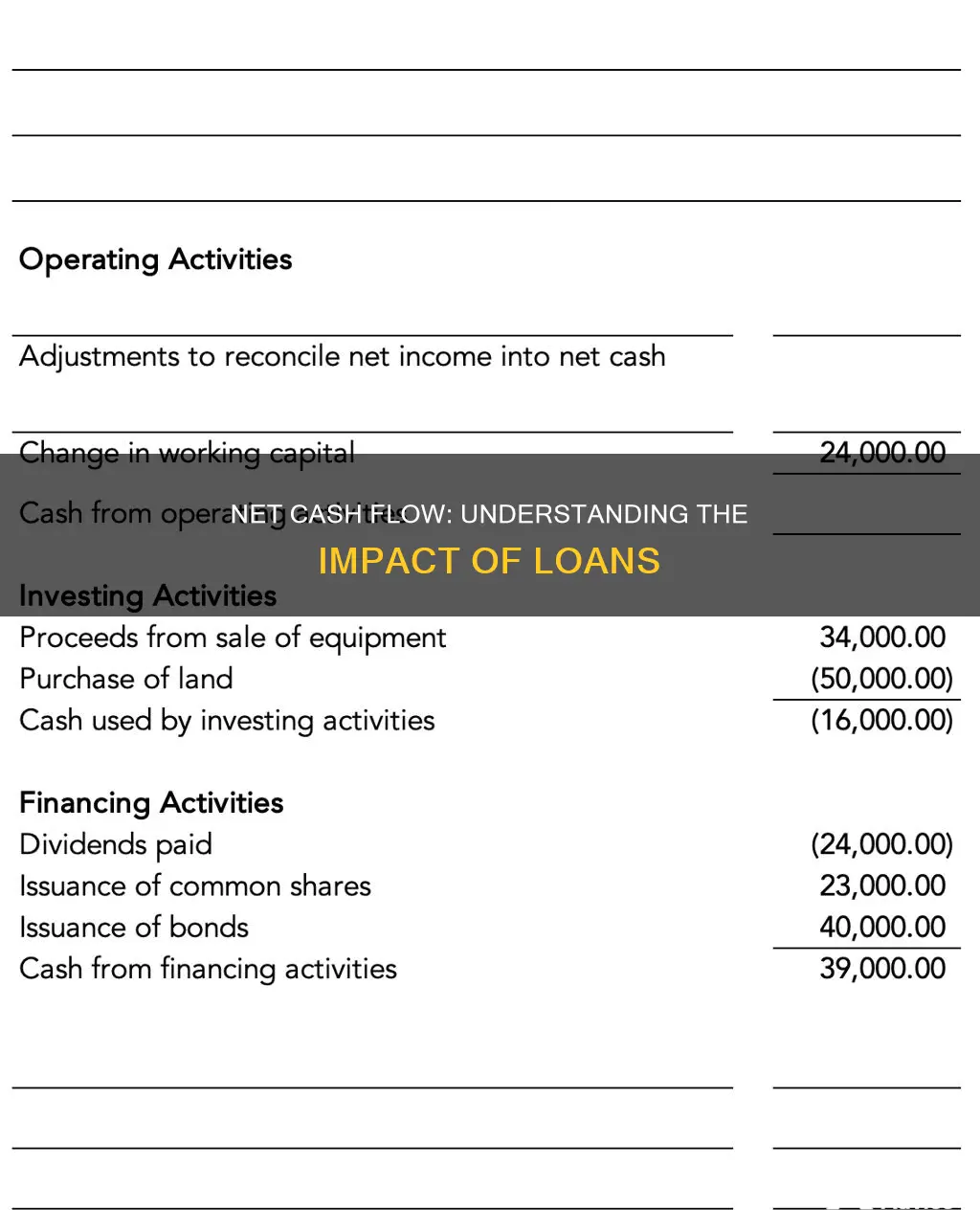
Net cash flow is a financial figure that is calculated by subtracting a company's total cash outflows from its total cash inflows. It is a useful metric for assessing a company's financial health and stability, indicating whether a company is earning more than it is spending. Net cash flow can be broken down into three main sources: operating activities (sales and day-to-day expenses), investing activities (buying or selling assets), and financing activities (loans, dividends, and crowdfunding). This final category, financing activities, is where loans are included in net cash flow calculations. This section of a company's cash flow statement shows how cash flows from a company's core business operations and whether the company can sustain itself without external financing.
What You'll Learn

Net cash flow from financing activities
Net cash flow is the difference between the cash coming into and going out of a business. It is a useful metric for financial stability, helping businesses cover costs, invest in growth, and manage unexpected expenses. Net cash flow is calculated by subtracting total cash outflows from total cash inflows.
Net cash flow can be broken down into three main sources: operating activities (sales and day-to-day expenses), investing activities (buying or selling assets), and financing activities (loans, dividends, crowdfunding).
A positive CFF means a company is raising more money than it is paying out, which might indicate growth and expansion. This could be a cause for concern if the company is relying too much on external financing, particularly debt, which can be difficult to repay and risky. A negative CFF means a company is paying down debt or returning capital to investors. This could indicate a healthy debt repayment process or, on the other hand, consistent cash outflows could represent strained liquidity.
To calculate CFF, you can use the following formula: CFF = Cash Inflows From Financing - Cash Outflows From Financing. It is important to note that neither a positive nor negative CFF is inherently good or bad, and it is necessary to understand a company's entire financial structure and business situation to determine the health of its cash flow from financing activities.
Gold Loan Impact: CIBIL Scores and Muthoot Finance
You may want to see also

Net cash flow from operating activities
The formula for calculating net cash flow from operating activities is straightforward: total cash inflows minus total cash outflows. Positive net cash flow from operating activities indicates that a company's core business activities are thriving, while negative cash flow may require careful planning to ensure financial stability.
There are two methods for presenting net cash flow from operating activities on a cash flow statement: the indirect method and the direct method. The indirect method starts with net income from the income statement and then adds back non-cash items, such as depreciation and amortization, to arrive at a cash basis figure. This method is used because, under the accrual method of accounting, revenue is recognized when earned, not necessarily when cash is received. For example, if a customer buys a product on credit, the sale is recorded as revenue, but the cash has not yet been received.
The direct method, on the other hand, tracks all transactions in a period on a cash basis, using actual cash inflows and outflows on the cash flow statement. This method provides a more transparent view of a company's cash position by considering only the cash that has been received and paid out during the period.
Affirm Loan Repayment: What Happens When Returning Purchases?
You may want to see also

Net cash flow from investing activities
Net cash flow is the difference between the cash coming into and going out of a business. It is a crucial metric for financial stability, helping businesses cover costs, invest in growth, and manage unexpected expenses. Net cash flow from investing activities is one of the three main sources of cash flow, alongside operating activities (sales and day-to-day expenses) and financing activities (loans, dividends, and crowdfunding).
A positive net cash flow from investing activities means that a company has generated more cash from its investments than it has spent on them. This could indicate that the company is investing in assets that will provide long-term benefits. On the other hand, a negative net cash flow from investing activities means that the company has spent more on its investments than it has made from them. While this could be a cause for concern, it may also indicate that the company is investing heavily in its future, such as through research and development (R&D) or the purchase of new company vehicles.
Analysts and investors use net cash flow from investing activities to understand a company's investment strategy and financial health. A positive net cash flow from investing activities can be a good sign, indicating that the company may have the capacity to pay dividends or buy back shares. However, a negative net cash flow from investing activities may prompt investors to question the effectiveness of the company's investment strategy and whether the company needs to find new sources of cash.
Income Impact: Loan Determination Factors Explained
You may want to see also

How to calculate net cash flow
Net cash flow (NCF) is a profitability metric that represents the amount of cash gained or lost by a business over a specific period. It is a useful indicator of a business's financial health and viability.
There are three main components to net cash flow:
- Operating activities: This includes income from selling products or services, as well as expenses for day-to-day activities like buying stock, paying employees, and covering utility bills.
- Investing activities: This includes capital generated by profitable investments or cash issued to make an investment or purchase fixed assets.
- Financing activities: This includes cash from bank loans, issuing shares, and small business crowdfunding efforts, as well as repaying debt and paying dividends to shareholders.
To calculate net cash flow, you need to find the total cash flow for each of these three categories. This can be done by adding up all the cash inflows and outflows for each category. Once you have the totals for each category, you can add them together to find the net cash flow.
Let's say a company has the following cash flows:
- Operating activities: $100,000
- Financing activities: $40,000
- Investing activities: -$60,000
To calculate the net cash flow, you would add up these values:
$100,000 + $40,000 + (-$60,000) = $80,000
So, the net cash flow for this company over the given period is $80,000, indicating a relatively strong financial position.
Understanding Nelnet Loan Interest: Principal or Outstanding?
You may want to see also

Net cash flow and a company's financial health
Net cash flow is a critical metric for evaluating a company's financial health and stability. It measures the difference between the cash inflows and outflows, indicating whether a company is bringing in more money than it is spending. A positive net cash flow suggests a business is in a healthy position, able to cover its expenses, invest in growth, and handle unexpected costs.
Net cash flow is derived from three primary sources:
- Operating activities: This includes sales revenue and day-to-day expenses, such as salaries, rent, utilities, and office supplies. It reflects the cash flow from a company's core business operations.
- Investing activities: This involves the buying or selling of assets, such as purchases of speculative assets, investments in securities, or sales of securities or assets. A negative cash flow in this category could be due to significant investments in the company, like research and development.
- Financing activities: This encompasses loans, shareholder dividends, and crowdfunding. It reflects how a company raises and manages its capital, including debt and equity transactions.
Calculating net cash flow is straightforward:
> Net cash flow = total cash inflows – total cash outflows
However, it is essential to note that net cash flow is just one aspect of a company's financial health. A more comprehensive analysis should consider other financial statements, such as the balance sheet, income statement, and profit and loss account. Additionally, cash flow analysis can provide deeper insights, helping to identify trends, spot potential issues, and inform strategic financial decisions. This analysis includes understanding cash flow patterns, liquidity, and the reasons behind financing activities.
In summary, net cash flow is a critical indicator of a company's financial health, providing a snapshot of its ability to manage expenses, invest, and maintain stability. However, a holistic assessment of financial health should involve a detailed cash flow analysis and a review of multiple financial statements.
Exploring NACA: Do They Offer Construction Loans?
You may want to see also
Frequently asked questions
Net cash flow is the difference between the cash coming into and going out of a business. It is calculated by subtracting total cash outflows from total cash inflows.
Net cash flow includes cash from sales, services, and other income streams, as well as expenses such as salaries, rent, utilities, loan repayments, and other operating costs. It also includes cash from financing activities such as loans, shareholder dividends, and crowdfunding.
Loans can impact net cash flow in a few ways. When a loan is taken out, it can increase the net cash flow by providing a source of funding for the business. However, loan repayments will decrease net cash flow as they are considered a cash outflow. The impact of loans on net cash flow will depend on the business's financial situation and strategy.







